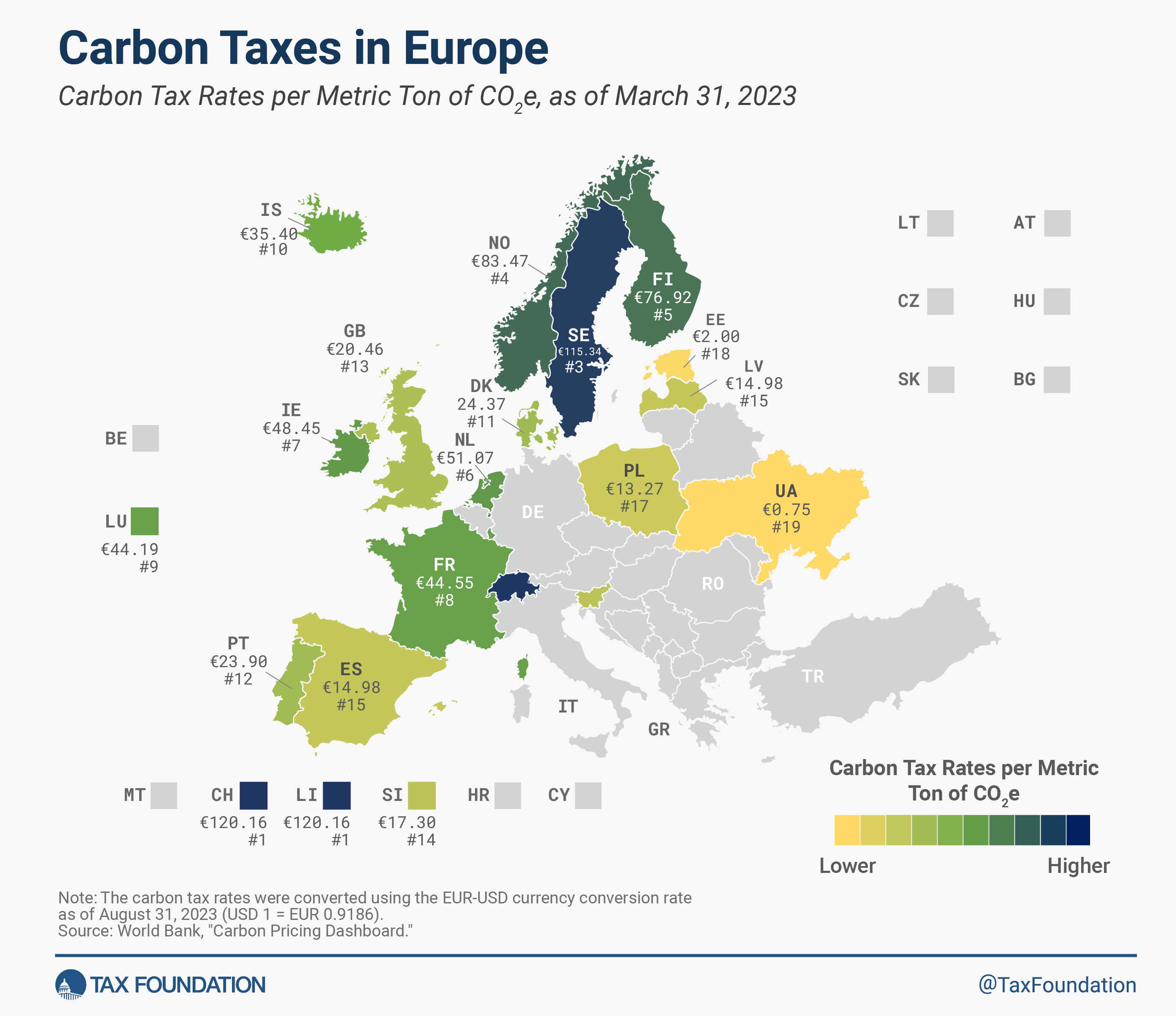In the past few years, many countries have taken steps to cut down on carbon emissions, such as putting in place environmental rules, emissions trading systems (ETSs), and carbon taxes.
Finland was the first country in the world to put a tax on carbon in 1990. Since then, 18 European countries have put in place carbon taxes, which range from less than €1 per metric ton of carbon emissions in Ukraine to more than €100 in Sweden, Liechtenstein, and Switzerland.
Switzerland and Liechtenstein have the highest carbon tax rate at €120.16 ($130.81) per ton of carbon emissions. Sweden and Norway are next at €115.34 ($125.56) and €83.47 ($90.86), respectively. Ukraine (€0.75, or $0.82) and Estonia (€2, or $2.18) have the lowest carbon tax rates.
Greenhouse gases like carbon dioxide, methane, nitrous oxide, and fluorinated gases can all be taxed based on their carbon content. Each country's carbon tax covers a different amount of greenhouse gas emissions because the tax's reach is different. For example, Spain's carbon tax only applies to fluorinated gases, which is only 2% of the country's overall greenhouse gas emissions. On the other hand, Liechtenstein covers more than 81% of its greenhouse gas emissions.
All European Union member states, plus Iceland, Liechtenstein, and Norway, are part of the EU Emissions Trading System (EU ETS), which is a market set up to trade a limited number of permits to release greenhouse gases. All European countries that have a carbon tax except Switzerland, Ukraine, and the UK are also part of the EU ETS. (Switzerland has its own ETS, but since January 2020, it has been linked to the EU ETS. After leaving the EU, the UK set up its own UK ETS in January 2021.
In Finland, Ireland, the Netherlands, and Norway, the national carbon tax base and the EU ETS pollution base overlap. This means that the overlap is taxed twice. When national carbon taxes are put on emissions that are covered by an ETS, the emissions tend to come from sources outside of the tax base. This means that the total amount of emissions that are limited by ETS permits stays the same.
Some countries use various excise taxes or ETSs with different implicit or explicit tax rates on sources of carbon emissions. In these cases, the rate shown in the table below is the largest one that applies. In an ideal world, a carbon tax would be charged at the same rate for carbon emissions from all industries.
In the past few years, a number of European countries have put in place a carbon tax or an ETS. Catalonia is thinking about putting a carbon tax in place at the subnational level.
2023 Carbon Taxes in Europe
| Carbon Tax Rate (Per Ton of CO2e) | Share of Jurisdiction’s Greenhouse Gas Emissions Covered (2018) | Year of Implementation | ||
|---|---|---|---|---|
| Euros | U.S. Dollars | |||
| Denmark (DK) | €24.37 | $26.53 | 35% | 1992 |
| Estonia (EE) | €2.00 | $2.18 | 6% | 2000 |
| Finland (FI) | €76.92 | $83.74 | 36% | 1990 |
| France (FR) | €44.55 | $48.50 | 35% | 2014 |
| Iceland (IS) | €35.40 | $38.53 | 55% | 2010 |
| Ireland (IE) | €48.45 | $52.74 | 40% | 2010 |
| Latvia (LV) | €14.98 | $16.31 | 3% | 2004 |
| Liechtenstein (LI) | €120.16 | $130.81 | 81% | 2008 |
| Luxembourg (LU) | €44.19 | $48.11 | 65% | 2021 |
| Netherlands (NL) | €51.07 | $55.59 | 12% | 2021 |
| Norway (NO) | €83.47 | $90.86 | 63% | 1991 |
| Poland (PL) | €13.27 | $14.44 | 4% | 1990 |
| Portugal (PT)(a) | €23.90 | $26.01 | 36% | 2015 |
| Slovenia (SI) | €17.30 | $18.83 | 52% | 1996 |
| Spain (ES) | €14.98 | $16.31 | 2% | 2014 |
| Sweden (SE) | €115.34 | $125.56 | 40% | 1991 |
| Switzerland (CH) | €120.16 | $130.81 | 33% | 2008 |
| Ukraine (UA) | €0.75 | $0.82 | 71% | 2011 |
| United Kingdom (GB) | €20.46 | $22.28 | 21% | 2013 |
| €44.97 | $48.95 | 36% | ||
| EU ETS(b) (For Reference) | €88.46 | $96.30 | 38% | 2005 |
|
Notes: (a) Portugal ties its carbon tax rate to the previous year’s EU ETS allowances price. (b) The ETS price displayed is provided for reference only and subject to daily changes. Real-time and historical carbon price data can be tracked using financial information tools provided by relevant exchange platforms. The carbon tax rates were converted using the EUR-USD currency conversion rate as of August 31, 2023 (USD 1 = EUR 0.9186). |
||||
|
Sources: The World Bank, “Carbon Pricing Dashboard,” last updated Mar. 31, 2023, https:// carbonpricingdashboard.worldbank.org/map_data; Financial Administration, Republic of Slovenia – Environmental Taxes, retrieved Aug. 31, 2023. |
||||



























